A planet where the years flash by in under three days has been discovered circling the brightest star in the Kepler star field of the Milky Way.
A team of 65 astronomers and mutiple telescopes led by Steve Howell, Deputy Project Scientist at the NASA Ames Research Center and a member of the Kepler Science Team, pinpointed the planet which takes a mere 2.8 days to orbit its star, Kepler-21. The planet, dubbed Keplar-21b, has a radius of 1.6 times that of Earth’s and a mass estimated at up to 10 times greater.
NASA’s Kepler Mission is part of a search “to find terrestrial planets (i.e., those one half to twice the size of the Earth), especially those in the habitable zone of their stars where liquid water and possibly life might exist”. The Kepler Mission aims to estimate how many of the Milky Way’s billions of stars have terrestial planets.
Kepler-21b is about 6 million kilometres from its star. In comparison, the closest planet to our sun is Mercury, which is 57 million kilometres from Sol. Earth is at a distance of about 150 million kilometres. The Kepler planet’s proximity suggests it won’t be suitable for colonisation, with scientists estimating a surface temperature of more than 1600 degrees Celcius.
The Kepler-21 system is relatively close, at 352 light years from Earth, but such distances mean that even if astronomers find what looks like a new Eden, none of our probes or rovers would be likely to make the trip for some time to come.

Astronomer Michael Brown, an ARC Future Fellow and Senior Lecturer at Monash University, said that “the distances to other stars are so vast that there’s just no plausible means of getting to any planets beyond our solar system for the foreseeable future. All probable technologies would take hundreds of years to get to the closest of stars.”
The distances make it hard to even see planets, Dr Brown said. In a few cases, scientists have been able to observe moments when a “planet passes in front of the star and a little bit of light from the star passes through the atmosphere of the planet and gets absorbed, so they can work out the composition of the atmosphere of the planet,” Dr Brown said.
“In a few special cases – with very, very peculiar systems – they’ve been able to take images of a star and see a little speck that looks like it might be a planet but you don’t the planet as a disc, you just see it as a spot of light,” Dr Brown said.
Our vision may improve, however, if NASA’s goes ahead with its concept of a Terrestrial Planet Finder, a suite of space-based observatories that would scan nearby stars for Earth-like planets.
“Looking some decades into the future, there’s ideas that you could link small telescopes in space together to act as a very large telescope and actually produce an image of a planet so that you could see if it was a blue dot with continents on it,” Dr Brown said. “For the moment the planets we see beyond our solar system will remain at best dots of light, or often it will be indirect observations.”
Planets discovered in 1998 Hubble images can be seen here.


